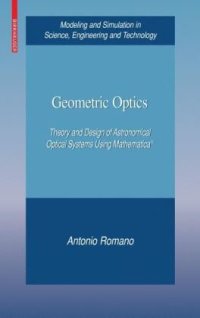
Ebook: Geometric Optics: Theory and Design of Astronomical Optical Systems Using Mathematica®
Author: Antonio Romano (auth.)
- Genre: Mathematics
- Tags: Mathematical Modeling and Industrial Mathematics, Optics Optoelectronics Plasmonics and Optical Devices, Microwaves RF and Optical Engineering, Geometry, Astronomy Observations and Techniques, Partial Differential Equations
- Series: Modeling and Simulation in Science Engineering and Technology
- Year: 2010
- Publisher: Birkhäuser Basel
- Edition: 1
- Language: English
- pdf
This book—unique in the literature—provides readers with the mathematical background needed to design many of the optical combinations that are used in astronomical telescopes and cameras. The results presented in the work were obtained by using a different approach to third-order aberration theory as well as the extensive use of the software package Mathematica®.
The newly presented approach to third-order aberration theory adopted is based on Fermat’s principle and the use of particular optical paths—not rays—termed stigmatic paths, allowing for easy derivation of third-order formulae. This approach enables readers to understand and handle the formulae required to design optical combinations without resorting to the much more complex Hamiltonian formalism and Seidel's relations.
Additional features and topics:
* Presentation of the third-order design of cameras and telescopes with the aid of Mathematica eliminates the need for tedious computer calculations
* Mathematica notebooks accompanying each optical combination analyzed in the book are available for download at http://extra.springer.com/978-0-8176-4871-8
* Discussion and analysis of specific optical devices: Newtonian and Cassegrain telescopes; Schmidt, Wright, Houghton, and Maksutov cameras; and other optical combinations, such as the Klevtsov telescope and the Baker–Schmidt flat-field camera
* Additional supplementary material available at the publisher's website
* Many worked-out examples and exercises
Geometric Optics is an excellent reference for advanced graduate students, researchers, and practitioners in applied mathematics, engineering, astronomy, and astronomical optics. The work may be used as a supplementary textbook for graduate-level courses in astronomical optics, optical design, optical engineering, programming with Mathematica, or geometric optics.
This book—unique in the literature—provides readers with the mathematical background needed to design many of the optical combinations that are used in astronomical telescopes and cameras. The results presented in the work were obtained by using a different approach to third-order aberration theory as well as the extensive use of the software package Mathematica®.
The newly presented approach to third-order aberration theory adopted is based on Fermat’s principle and the use of particular optical paths—not rays—termed stigmatic paths, allowing for easy derivation of third-order formulae. This approach enables readers to understand and handle the formulae required to design optical combinations without resorting to the much more complex Hamiltonian formalism and Seidel's relations.
Additional features and topics:
* Presentation of the third-order design of cameras and telescopes with the aid of Mathematica eliminates the need for tedious computer calculations
* Mathematica notebooks accompanying each optical combination analyzed in the book are available for download at http://www/birkhauser.com/978-0-8176-4871-8
* Discussion and analysis of specific optical devices: Newtonian and Cassegrain telescopes; Schmidt, Wright, Houghton, and Maksutov cameras; and other optical combinations, such as the Klevtsov telescope and the Baker–Schmidt flat-field camera
* Additional supplementary material available at the publisher's website
* Many worked-out examples and exercises
Geometric Optics is an excellent reference for advanced graduate students, researchers, and practitioners in applied mathematics, engineering, astronomy, and astronomical optics. The work may be used as a supplementary textbook for graduate-level courses in astronomical optics, optical design, optical engineering, programming with Mathematica, or geometric optics.